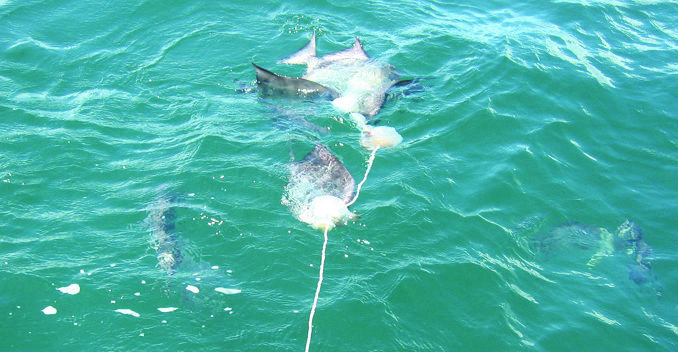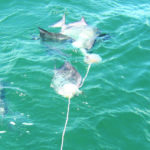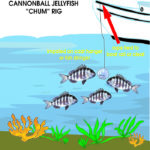
The cannonball jellyfish, stomolophus meleagris, has great value as table fare in Asian countries, but along the South Carolina coast, it’s mainly recognized as being the No. 1 food of certain species of sea turtles and the No. 1 bait for spadefish.
“Jellyballs are by far the best bait for spadefish, but they’re also the messiest,” said Capt. Mike Waller. “They don’t have any tentacles that hang down, and they don’t really sting, and you can catch ’em coming out of any inlet with a dip net.”
Cannonball jellyfish are yellowish-brown in color and can grow to eight inches in diameter. When it comes to spadefish, they’re used whole and in pieces — as chum and on a hook.
“You can cut one up and throw out the pieces, and they’ll come up close to the boat,” Waller said. “You don’t ever want to put a jellyball in your livewell, because if you’ve got mud minnows or finger mullet or menhaden in there, it will kill them all — for a couple of days. I keep them in a separate bucket.”
But most fishermen who do any amount of fishing for spadefish quickly learn that a whole jellyball is the way to get the attention of a school of spadefish.
“If you’ve got a jellyball, you can hold the spadefish in one spot; it will keep them grouped up at the side of your boat,” Capt. Tom Siwarski said. “You can put a coat hanger through them, tie it to a rope and drop it down next to the boat. After a while, you can see the line jumping when they start to eat the jellyball. You can raise it a foot or two at a time, and they’ll following it right to the back of the boat where you an see ’em. You can get ’em as shallow as two or three feet.”
Waller likes to impale a jellyball on a big fish stringer, making a loop and tie the stringer off to his boat. He likes to drop the jellyball down to the structure he’s fishing, then slowly raise it toward the surface.
“When the ocean’s flat, you can see them down there, biting that jellyball,” he said.
Once the jellyball has the attention of spadefish, it’s just a matter of cutting one up for bait. Some fishermen cut long slivers out of the jellyball; Waller prefers a chunk about the size of your thumbnail.
Editor’s Note: This is part of the South Carolina Sportsman article “Spade Flush,” which is available now in the April issue. This magazine is now on newsstands around the state. Click here to subscribe to South Carolina Sportsman magazine and ensure you don’t miss future where-to, how-to articles.





Be the first to comment